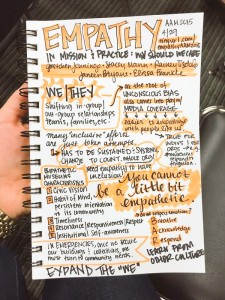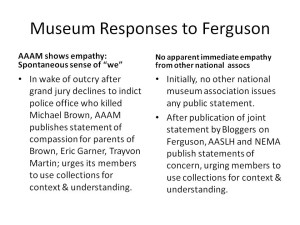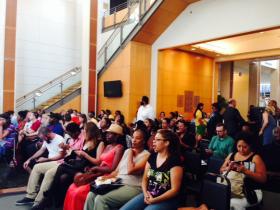Remain true to yourself, but move ever upward toward greater consciousness and greater love! At the summit you will find yourselves united with all those who, from every direction, have made the same ascent. For everything that rises must converge.” Pierre Teilhard de Chardin. 1942.
I’m not sure why this phrase “Everything that rises must converge,” popped into my head after AAM, but pop it did, and so I began to investigate its origins. I remembered I had started reading Flannery O’Connor about a year ago, and it is the title of one of her short story collections. But I felt I had seen the phrase before I read O’Connor, and a quick search revealed that it originated with de Chardin—a French priest, paleontologist, and writer on evolution whose works O’Connor would’ve known and whose books I read years ago. I found the context of the quotation even more meaningful, so included the whole thing above.
As many readers know, the theme of AAM’s conference this year was “Museums and Social Value.” I first thought of the meeting as a great bowl created at just the right time to contain all the aspects of this topic. Another example of convergence. But in light of the de Chardin quotation perhaps it’s better to think of the conference as a strong gust of wind or a tide that has lifted into view a wide variety of ideas, questions, challenges, initiatives, oratory, and exhortation relating to the civic responsibilities of museums and their role in the social fabric of our society. Here are the specific convergences that I have reached out and grasped from this whirlwind of ideas:
The convergence of The Empathetic Museum and the #museumsrespondtoFerguson initiative.
I’ve been thinking and writing about both of these topics for some time, and they came together in two sessions, “Empathy in Mission and Practice” on the AAM’s conference schedule and the #museumsrespondtoFerguson” discussion sponsored by The Museum Group in its conversation series held during AAM. It is almost a year since Michael Brown was shot in Ferguson, MO in August, 2014. The museum field has responded in a variety of ways, and there is a certain sense in which that range of responses is a kind of litmus test for institutional empathy.
At the #museumsrespondtoFerguson conversation, as well as during our regular session, there were calls, especially from African American participants and panel members, for greater mutual respect and commitment to equal partnership on the part of museums as they seek collaboration with audiences they seek but who do not participate in large numbers. As we affirmed in the session: A lack of empathy in museums is the greatest obstacle to the inclusiveness we all say we want.
The convergence of #museumsrespondtoFerguson and Baltimore
Despite its awkward length, the #museumsrespondtoFerguson hashtag has survived and expanded both in use and meaning since it first appeared in late November, 2014 in the wake of the Ferguson protests. The hashtag features prominently in Twitter chats on the third Wednesday of every month, when @AdrianneRussell and @AleiaBrown discuss a wide variety of topics related to museums, inclusiveness, race, diversity policy, and much more.
Ferguson and Baltimore converged during the AAM Conference, when the city of Baltimore experienced both peaceful marches and violent demonstrations protesting the death of Freddie Gray. Gray was fatally injured while being arrested and detained in police custody for what were later determined to be not even minor offenses. On the morning of April 27, after some Baltimore neighborhoods had been burnt and looted, conference participants, many from Baltimore, gathered for a session called “Missouri Burning. ” Melanie Adams of the Missouri History Museum spoke about her museum’s timely and consistent work with greater St. Louis community, especially since Michael Brown was shot in nearby Ferguson, MO. At the end of the session colleagues working in Baltimore museums shared their concern for their city and their determination to put their museums’ resources toward healing and communication once they returned home.
The next day blogger Robert Connolly wrote Baltimore Museums Respond, referencing #museumsrespondtoFerguson and detailing the steps institutions such as the Reginald Lewis Museum, the Walters, the Contemporary, the Baltimore Symphony, and the Enoch Pratt Library were taking to show solidarity with the city and the community.
The convergence of #museumsrespondtoFerguson and #MuseumWorkersSpeak
As the hashtag becomes more widely known, it is being used in connection with other social media initiatives related to social justice both outside (#blacklivesmatter) and inside (#MuseumWorkersSpeak and @MuseumWorkers) the field. The MuseumWorkers group met in a “rogue” session during AAM. Since then, in DC at least, there is a monthly meeting to discuss both #museumsrespondtoFerguson and#MuseumWorkersSpeak. Twitter is the best place to find out about meetings, next steps, etc.
The convergence of awareness and discussion of coded language in the museum field
I have been working on issues of cultural and racial inclusiveness in museums all of my museum life, which began in 1978 at the Museum of African Art. Then a private museum in Washington, DC, it became the Smithsonian’s National Museum of African Art. Although I have spoken and written about the misuse and misunderstanding of cultural symbols and terms, for example here, I don’t remember ever seeing so much discussion about coded vocabulary in museum discourse as in the past year.
Terms such as “white privilege” and “racialized spaces,” are being openly examined during the monthly Twitter chats led by Russell and Brown. In addition, Rose Paquet Kinsley, Alethia Wittman, and Porchia Moore have been writing about coded language on the Incluseum blog. A session at AAM, “Using our Words: Inclusive Language and Social Value, led by Moore, Paquet and Margaret Middleton explored these and other terms and phrases like “community,” “underserved,” ” invite to the table,” “outreach” for their coded and sometimes offensive meanings. The session is summarized on a recent Incluseum post. We need much more discussion on this sensitive topic, but at least it has come out into the open.
The synergy of social media and social justice
Social media facilitates timeliness, communicates a sense of urgency and of community and allows those without official authority a voice. All of the sessions and initiatives discussed above have either been born through, or have had their reach greatly expanded by, social media.
The official authority of the AAM Conference theme provided a venue and a time frame for much of this discussion–and the role of this platform in lifting and generating discussion is hugely important. Even in a time of “open authority” the official voice has great power and impact. I think this conference will have continuing impact on the field.
At the same time, the individuals organizing chats, rogue meetings, pop-up sessions are not “the usual suspects” in terms of museum leadership. They are younger, often unaffiliated with specific museums, and more diverse than in the past. (I was going to change the verbs in the previous sentences to “were,” but another characteristic of social media is its ability to transcend time.) Before, during, and since the conference, the conversation on Twitter, Facebook, and blogs exists and persists. And this leads directly to the final convergence:
The coming together of younger and older museum colleagues around common issues.
The common interest and enthusiasm of a wide range of age groups around these issues has been really gratifying. Younger and newer museum colleagues are taking a leadership role, and it’s wonderful to see.
All of us working for the social value of museums should remember, “remain true to yourself….you will find yourselves united with all those who, from every direction, have made the same ascent. For everything that rises must converge.”
If you are reading this post as part of an email, you can go to www.museumcommons.com to comment. Or send a response to @gretchjenn on Twitter. I look forward to hearing from you.



Pingback: Michelle Obama, “Activism”, and Museum Employment Part II | the incluseum
Hi Gretchen, the Incluseum is about to publish a blogpost that attempts to make explicit the relatedness of things that tend to be treated as separate (more soon). I wanted to share that I love the idea of convergence and the quote you shared; it beautifully captures the intuition the Incluseum blogpost authors have and the sentiment we are trying to convey. We will use (and credit you/link to) this! Thank you.
I’m so happy it struck a chord You are right about intuition. Now I know the origin of the phrase but how and why it came to me at this time I just don’t know. The mind really works in mysterious ways. Best- Gretchen